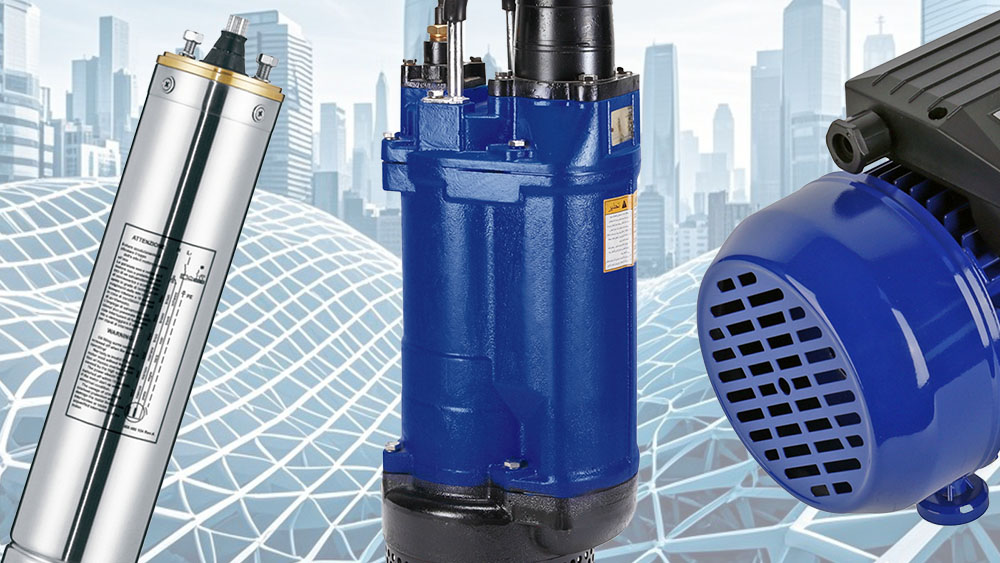+86 13816508465
Pump Knowledge
Aug. 19, 2025

The efficiency and reliability of a pump motor hinge on one crucial factor: effective cooling. Overheating can lead to reduced performance, increased wear, and even motor failure. That's why choosing the right cooling method is essential for both the performance and longevity of pump motors. Three primary methods dominate the industry—air-cooled, water-cooled, and oil-filled. Each has its unique features, advantages, and limitations.
This guide explores these three pump motor cooling methods in detail and provides actionable insights to help you select the most suitable option for your pump system.
Pump motors generate significant heat during operation. If not managed properly, this heat can degrade motor components, leading to malfunctions or costly downtimes. A dependable cooling system ensures optimal operating temperature, enhances motor efficiency, and extends service life. By understanding and selecting the right cooling technology, you can avoid unnecessary wear and enjoy a smoother, longer-lasting performance from your pump motor.
Let's examine the three main cooling methods in detail.
Air-cooled pump motors rely on air circulation to dissipate the heat generated during operation. A fan, either integrated or externally mounted, circulates air over the motor’s housing or fins to carry away heat.
How Does Air Cooling Work?
The motor's design typically incorporates fins or housings with increased surface area, allowing heat to transfer more effectively to the surrounding air. A fan creates airflow over these surfaces, which then dissipates the accumulated heat.
Benefits of Air-Cooled Pump Motors
1. Simple Design: Air-cooled motors have fewer components and do not require additional systems like plumbing or liquid reservoirs.
2. Low Maintenance: Without liquids to monitor or replace, these motors demand minimal maintenance.
3. Cost-Effective: The absence of complex cooling systems makes production and operation more affordable.
Limitations of Air-Cooled Pump Motors
1. Less Efficiency in Hot Environments: High ambient temperatures can diminish cooling performance.
2. Noise from Fans: The fan mechanism, while effective, may produce operational noise.
3. Limited Capacity: Air cooling is best suited for smaller motors rather than high-power applications.
Common Applications
Air-cooled pump motors are frequently used in:
Small centrifugal pumps
Domestic water pumps
Light industrial applications
Water-cooled pump motors use liquids, such as water or glycol-based solutions, for heat dissipation. This method involves either circulating water through an external cooling jacket or directing it around motor components.
How Does Water Cooling Work?
A closed-loop system ensures consistent water circulation around the motor housing or internal components. The heated water is cooled and recirculated or replaced continuously, depending on the design.
Benefits of Water-Cooled Pump Motors
1. Superior Heat Transfer: Water is an excellent conductor of heat, enabling efficient cooling even in high-powered systems.
2. Quiet Operation: With no fan noise, water-cooled motors are much quieter.
3. Ideal for High-Power Applications: These motors are designed to handle demanding workloads and harsh conditions.
Limitations of Water-Cooled Pump Motors
1. Additional Plumbing Requirements: Installing water-cooled systems involves setting up plumbing and ensuring consistent water flow.
2. Potential for Leakage or Scaling: Long-term use can cause calcium deposits, restricting water flow, or lead to leaks if seals fail.
3. Higher Initial Costs: The complexity of installation and components increases upfront costs.
Common Applications
Water-cooled pump motors are ideal for:
Industrial pumps
HVAC systems
Large-scale irrigation pumps
Oil-filled pump motors rely on oil immersion to manage heat. The oil serves a dual purpose, providing both cooling and lubrication for the motor's moving components.
How Does Oil Cooling Work?
The motor is completely sealed and filled with an oil coolant. Heat generated during operation transfers into the oil, which then dissipates it to the motor casing and surrounding environment.
Benefits of Oil-Filled Pump Motors
1. Thermal Stability: Oil effectively absorbs and retains heat, avoiding sudden temperature spikes.
2. Protection Against Moisture: The oil-filled design minimizes the risk of moisture infiltration, making these motors ideal for submerged applications.
3. Extended Motor Life: With combined lubrication and cooling, the motor's components experience reduced wear and tear.
Limitations of Oil-Filled Pump Motors
1. Higher Costs: Due to the complexity of sealing and design requirements, these motors are often more expensive.
2. Bulkier Design: Oil-filled motors are typically heavier than their air- or water-cooled counterparts.
3. Need for Secure Sealing: Proper seals are essential to prevent leaks or contamination.
Common Applications
Oil-filled pump motors excel in:
Submersible pumps
Sewage pumps
Well pumps
Choosing the right cooling method depends on your specific application. Here's a quick comparison:
Cooling Method | Efficiency | Maintenance | Cost Implications | Best Applications |
Air-Cooled | Moderate | Low | Affordable | Domestic, small pumps |
Water-Cooled | High | Moderate (plumbing upkeep) | Medium to high | Industrial, HVAC, irrigation pumps |
Oil-Filled | Very High | Moderate to High | High | Submersible and high-moisture areas |
When selecting a cooling system for your pump motor, consider the following:
1. Application Requirements: For smaller or indoor systems, air cooling often suffices. For high-power or industrial applications, water or oil cooling may be essential.
2. Operating Environment: Consider the ambient temperature and exposure to moisture or dust. Oil cooling protects best against moisture, while water cooling excels in demanding, hot environments.
3. Budget: If cost is a concern, air-cooled motors are the most economical. However, they may not suit high-load applications.
4. Maintenance Capabilities: Evaluate whether you can manage the additional maintenance required by water or oil systems.
Motor cooling is a critical factor in ensuring consistent pump performance and reliability. Whether you opt for air-cooled, water-cooled, or oil-filled pump motors, each system offers unique benefits tailored to specific needs. Evaluate your application carefully, keeping performance, environment, and budget in mind, to find the perfect match for your pump system.
By selecting the right cooling method, you can enhance efficiency, reduce downtime, and extend the lifecycle of your pump motor.
Address
No.17 XeDa Jimei Ind. Park, Xiqing Economic Development Area, Tianjin, China
Telephone
+86 13816508465
QUICK LINKS